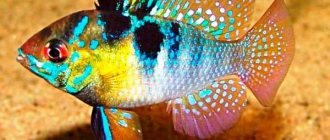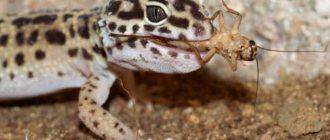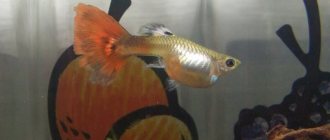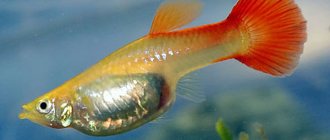Habitat
Initially, these fish lived in freshwater bodies of Brazil, Venezuela and Guiana. Gradually, they began to be artificially populated in other rivers and lakes.
This was done to reduce the population of malaria mosquitoes. As it turns out, guppy fish happily eat their larvae.
Guppies in nature are completely different from the inhabitants of home aquariums. Males and females are smaller in size, and the coloring is not as luxurious
Important! Aquarium guppies bred in artificial conditions differ significantly from their natural appearance. The difference is not only in color, but also in the huge variety of tail shapes.
Today, acclimatized guppies even live in the Moscow River, reservoirs of Yaroslavl, Nizhny Novgorod, Tver and Rybinsk.
What plants do you need in a guppy aquarium?
Your wards cannot boast of size, so plants for guppies are also needed with small leaves. The best option is Indian fern . It has finely dissected leaves. He needs approximately the same conditions as the guppies.
Indian fern aquarium plant
Another suitable plant is nitella . Its thin string-like leaves are not only a place where fry can land, but also a natural filter on which some suspended matter is retained. This makes the water in the aquarium clear, which is very important for guppies.
Nitella aquarium plant
The fry love to drift in the floating riccia . The plant, like fish, does not tolerate insufficient light and does not like cold water.
Aquarium plant floating riccia
Carolina cabomba looks very beautiful . Its delicate, weightless appearance is so suitable for a sophisticated guppy.
Carolina cabomba aquarium plant
In principle, you can plant any plants for guppies in an aquarium that require the same microclimate as the fish; the only thing undesirable is hard leaves, on which the fish can break off their magnificent tail.
Characteristic
These aquarium fish got their name thanks to a priest from England - John Guppy.
He first gave a report on them in 1886 to members of the Royal Society.
And although his stories about fish that do not spawn but give birth to fry were ridiculed, the study of this type of viviparous fish did not end.
Interesting fact! Guppy is the first fish to go into space. In addition, during their stay on the spaceship in a special aquarium, the fish gave birth to offspring, which were then studied by scientists for a long time. But, unfortunately, all materials were classified.
Guppies are very peaceful and fairly easy-to-care fish. But in some cases, males can bully each other in the fight for the female.
This usually does not cause serious damage, but the tails may be frayed.
Males, when showing off in front of females, can fluff their tails
It is best to choose peace-loving fish as neighbors for guppies. Most often these are small catfish. You should not add amphibians such as axolotls .
Interesting! piranhas kept in aquariums .
It is ideal to house several pairs of guppies per 20-30 liters. For small quantities, it is not even necessary to install a filter and aeration.
It is enough just to periodically change the water and provide good lighting. However, in order to achieve the most effective results, you should not leave things to chance.
Appearance
Seeing the couple for the first time, one cannot help but notice some injustice. After all, males are much more beautiful than females. The latter are completely nondescript.
Females have a grayish color and normal-looking tails, which are also faded in color.
The males are truly beautiful: their veiled tails with a wide variety of colors can inspire.
At the same time, male fish are much smaller: they grow up to 3-4 cm in length, while females can reach 6 cm.
If you want to get yourself a snail in an aquarium, we recommend that you read the article
Male guppy fish look much more luxurious than females. Their main value is their luxurious tail, in which all the colors of the rainbow can shimmer.
Important! To maintain the beauty of males' tails, it is recommended not to forget about periodic water changes. Good lighting is also very important.
The following types of breeds are distinguished:
- Fantail;
- Veiled;
- Voile-scarf;
- Carpet;
- Red-tailed semi-black also known as Berlin;
- Round-tailed;
- Tape;
- Leopard;
- Emerald, which is also called Winner's guppy;
- Scarf;
- Mesh.
Males are distinguished by the presence of a gonopodium, a special organ that is formed from the anal fin when the individual matures.
How not to buy sick fish
When purchasing new inhabitants for your aquarium, pay attention to their appearance and behavior. Healthy fish should:
- have shiny, bright eyes. In sick fish they are cloudy and whitish;
- when you see a person, swim to the front window, and not hide in the corners;
- swim through all levels of the aquarium, do not make chaotic, erratic movements.
If you notice white spots, bumps, or frayed fins on at least one of the fish for sale, you should not buy even healthy-looking fish from this aquarium. They may be infected with the same disease. If you doubt that the fish are healthy, do not make a purchase.
After purchasing fish, in order to avoid infecting the old-timers, newcomers must be kept in a separate aquarium for a week or two.
Peculiarities
Although the phrase “easy to care for” is often seen in the description of these aquarium fish, it should be remembered that even easy-to-keep pets have their own characteristics.
First of all, it is worth paying attention to the fact that the lifespan and size of individuals directly depend on the water temperature.
In addition, it changes the gestation period in females and the maturation period of males.
If the temperature is high enough (27 to 30 degrees Celsius), the lifespan is about a year, and the size of the individuals becomes progressively smaller.
Pregnancy in females lasts less. To increase the lifespan of guppy fish, it is recommended to maintain the temperature between 22 and 25 degrees Celsius.
The photo shows a female and a male. Adults differ significantly from each other
Important! Failure to comply with the basic conditions for keeping fish can lead to them becoming aggressive. It can also be caused by adding certain chemicals to the water.
Guppies are viviparous fish. The period of “gestation” of fry is approximately 1-1.5 months. Moreover, the older the female, the larger her brood.
The fry are born fully formed and ready for independent life.
Another feature is that the female can bear offspring, even if the male has not been around for a long time.
Often, when buying a female at a pet store, you can expect offspring within 1-1.5 months.
Conditions for keeping unpretentious fish
In addition to their compact size and bright coloring, the described fish are also famous for their unpretentiousness to living conditions. The truth is, how easy it will be for you to raise guppies largely depends on their basic coloring and the shape of their fins.
For example, representatives of the “gray” group are less capricious than light ones, although they, in turn, are not as picky as albinos. At the same time, individuals with large fins need more care than forked and short-finned species - they even reach sexual maturity at different ages.
The conditions of keeping are also influenced by the adaptation features of the fish: the temperature and hardness of the water in the aquarium suitable for specific individuals, the regularity and quality of feeding, etc. Before buying guppies, do not forget to ask the seller what conditions they lived in before.
In most cases, the optimal temperature range for liquid in an aquarium will be +24...+26°C, although many species are able to survive at lower or higher temperatures - from +14 to + 33°C. As for water hardness, the most acceptable level for guppies is 4-10 dH.
If you want to raise good males, then their planting density should not exceed 1 individual per 1 liter of water, and when raising females, the amount of liquid doubles.
The water in the tank should be regularly changed to fresh water, pre-infused for several days and brought to the temperature familiar to the fish. Typically, one-third of the total fluid volume should be replaced each week.
Important! Guppies feel better and develop more actively if, when keeping them, sea salt is added to the aquarium along with iodine tincture (for every 10 liters there is one and a half teaspoons of salt and 1 drop of 5% iodine solution): care will be easier and the reproduction of the fish will accelerate.
Lighting plays a significant role in the well-being of your pets. In this matter, it is worth remembering that with the arrival of winter, the aquarium should be illuminated for 10-12 hours, and in the summer the specified time is increased to 12-14 hours. However, this should not be only artificial lighting, so place the aquarium so that the sun's rays shine on it in the morning (to prevent the spread of algae, hang a gauze curtain on the container).
Nutrition
The most favorite food of these aquarium fish is bloodworms. Although in fact, fish are absolutely omnivorous.
On average, one adult male eats from 10 to 20 pieces per day. small bloodworm. The female should receive at least 3-5 larvae.
In addition to this type of food, you can feed plankton, asplancha, annelids, lower plants, and growths on algae.
It is best not to give the entire amount of food at once, but to divide the food into several doses.
The first meal should take place no earlier than half an hour after the lights are turned on, and the last meal should take place no later than an hour before the lights turn off.
What to feed guppies?
The unpretentiousness of small fish is also evident when feeding them. Both live and specialized dry fish food, which is easy to find in the appropriate stores, are perfect for this task. Granules, flakes and other similar compounds are eaten by guppies with great pleasure, but when choosing them it is better to give preference to well-known brands: for example, Tetra. The best live food options are brine shrimp, bloodworms, tubifex worms, and coretras.
Important! If you are concerned about the brightness of the color of the fish, then the introduction of “live” food into the diet is a mandatory condition for keeping them.
In any case, always remember that guppies have a small mouth and an equally small stomach, which means that it is better to feed them in small portions 2-3 times a day.
The optimal amount of food per serving can be determined based on the rate of its absorption by the fish: they should eat everything in 2-3 minutes.
All leftover food should be removed from the aquarium in a timely manner, as otherwise it will begin to sour and can cause problems with the gastrointestinal tract of the fish. Do not overfeed the guppies; it is better if they starve for several days. With sufficient lighting, filamentous algae will appear in their habitat, which is also a good option for feeding your charges. As an alternative, you can use food containing a large amount of plant substances for feeding, which will help normalize the functioning of the fish’s gastrointestinal tract and increase their immunity.
Important! Dry nutritional compositions include dried daphnia, which is easy to find in poultry markets, but such food is not suitable for guppies, since it is very poor in nutrients and vitamins, but can harm the stomach.
When choosing a diet and determining the regularity of feeding fish food, the following should be considered:
- per adult male per day there should be 10-20 pieces of small bloodworms (about 8 mm in length), and per female - 3-5 pieces (depending on age and size);
- Adults benefit from weekly fasting (1 or 2 fasting days), when feeding is not carried out;
- You should start feeding the guppies no earlier than half an hour after turning on the lighting in the aquarium, and stop this process no later than an hour before turning it off.
- All uneaten remains should be removed 45-60 minutes after feeding.
Proper nutrition is the key to health and rapid development, so do not underestimate the importance of these requirements.
Reproduction
Fish breeding occurs without any problems. Of course, you still need to read the description and care instructions.
Females can bear offspring several times after one fertilization. On average, their gestation period ranges from 30 to 45 days.
The duration is primarily affected by water temperature.
In addition to the timing, the number of fry also varies. This factor is influenced by age and body size.
The first time a female is fertilized, she brings on average about 10-15 fry. Further, the number increases and can reach up to hundreds.
Important! Guppies, although peaceful, do not monitor their offspring at all. If they are hungry, they can swallow the fry without a twinge of conscience. In this regard, if the goal is to preserve the offspring in full, it is recommended to place the female in a separate container when the “X” hour approaches. Even a 3-liter jar is suitable as a “maternity compartment”, where it is advisable to put several bushes of algae at the bottom. After the birth is over, she returns to the general aquarium, and the fry grow separately.
Before labor begins, the abdomen becomes more square in shape.
A harbinger of the onset of labor in a female is an enlarged abdomen, often rectangular in shape, and a darker color of the birth mark.
Gradually, the female sweeps out all the fry, which can immediately swim and feed. Although, on the first day, bushy algae become their best friends, where they get used to the new environment.
On the second day of life, the fry is already eating normally and swimming freely in the aquarium. It’s still hard to say who it is – a female or a male. When he sees danger (other fish), the baby immediately hides among the algae
Care and maintenance
Goopiks have many advantages, one of which is ease of maintenance even for beginner aquarists. But, despite the apparent ease, you need to care for guppies correctly, especially for hybrids - they are weaker in health and more demanding. The concept of “good care” includes:
- correct choice and design of the aquarium;
- maintaining optimal environmental conditions;
- feeding;
- reproduction;
- selection of compatible fish species;
- prevention and treatment of diseases.
Let us consider the features of keeping gupeshkas in detail.
Aquarium
Guppies are tiny fish, but they need a large tank. It is not customary to keep these pets alone in a small aquarium, since the lack of company has a bad effect on their vital activity. When forming a fish family, it is recommended to take two thirds of the females for one third of the number of males. For a school of fish you will need an aquarium with a volume of at least 20 liters. The shape of the aquarium does not matter; you can use both rectangular and rounded ones. The main condition is that the water level is at least 35–40 cm high.
Note! The minimum capacity of the aquarium is calculated based on the number of pets: one fish must have at least three liters of volume. We must not forget that some part of the space will be occupied by equipment and decorations.
Having chosen an aquarium for your guppy, equip it with the necessary equipment:
- compressor for water aeration (oxygen saturation);
- a low-power filter that ensures water purity, but is harmless to fish;
- a lamp that does not need to be on constantly, a few hours a day is enough;
- heater with thermostat.
An integral part of the aquarium is the interior design. Guppies primarily swim near the surface of the water, but they also like to hide in the grass. Having filled the soil at the bottom of the aquarium, algae and floating plants are planted and secured. Relevant options are cryptocoryne, vallisnernia, moss, elodea. A good choice is Indian fern, which serves as an indicator of water conditions. If the plant rots, it means that the stagnant water needs to be changed urgently.
Optimal temperature and water quality
Fish do well in warm or cool environments, as long as there are no sudden changes. The temperature range of water in a guppy aquarium is quite wide - from 19 to 29 ºC. Rule for replacing water: replace no more than 30% of the volume at a time.
Water quality indicators:
- hardness should be in the range of 8–15 units;
- acidity pH not more than 7.5.
You can improve the composition of the water using sea salt: for every 10 liters of liquid, take 1-2 teaspoons of salt and pour it into the aquarium. This will strengthen the fish’s immunity and avoid pathologies such as splitting of the caudal fin.
Feeding
It is believed that guppies are absolutely not picky about the quality of food. They are omnivores and can be content with both dry mixtures and live insects and worms. Chopped seafood, beef, and plant components can be safely poured into an aquarium with guppies - these fish will greedily eat everything. However, excess food negatively affects health and leads to obesity, so pets need to be fed according to a schedule. The fry are fed flakes three times a day, and when they grow up, they are transferred to two feedings a day. Balanced, high-quality food with plant and animal ingredients, minerals and vitamins promotes active growth of fish.
Interesting fact! The consequences of starvation for guppies are not as bad as overfeeding. A healthy adult fish can easily survive a week without food.
Breeding
Guppies are viviparous fish: they do not produce eggs, but fry, protected by a thin shell. Males and females are visually distinguished by body size, lush caudal fin and the presence of a gonopodium - a modified anal fin. With the help of this organ, fertilization occurs. When fish of different sexes live in an aquarium, reproduction occurs easily, and in a female that has been inseminated once, pregnancy can occur several times in a row.
When the gestation period (5–7 weeks) ends, a dark spot appears on the female’s belly closer to her tail. Professional recommendation: for spawning, the female should be placed in a separate small aquarium to avoid the mother from eating the babies. The number of fry varies - from 10 to 100 fish. After birth, the fish are returned to the aquarium, and the fry are left alone and do not need care.
Compatibility with other fish
If the aquarium has sufficient capacity, guppies can coexist with other small fish:
- platies;
- mollies;
- speckled catfish;
- zebrafish;
- neons;
- cardinals.
Peaceful guppies in the aquarium also get along with swordtails, but sometimes suffer because of them: some aggressive individuals try to pinch the tail and fins. Cocky barbs are also capable of harming weak gulls. It is not recommended to add them to cichlids and angelfish. Helpful advice: when choosing neighbors, take into account similar living conditions - water parameters, diet. This will make it easier to care for both guppies and other waterfowl.
Diseases
Taking good care of your guppies is not always a guarantee that the fish will not get sick. Pets are hardy, but sometimes the immune system cannot cope with the infection or a serious injury occurs.
Common diseases:
- tuberculosis (mycobacteriosis) – the back is arched with the abdomen retracted;
- scoliosis – curved spine;
- red scab - plaque on the tip of the tail;
- fin splitting;
- fin rot;
- plystophorosis - invasions.
Important point! It is difficult to treat fish, so often sick individuals are destroyed and the aquarium is disinfected. If the fish gets sick after an injury, you need to understand the reasons and prevent the possibility of re-injury.
Lifespan
Sometimes a fish's illness is just a sign of its aging. Aquarium guppies live on average 3-4 years, under favorable conditions - up to 5 years. One of the factors for longevity is temperature: for guppies, excessive heat is more harmful than beneficial. In warm water, metabolic processes accelerate, and old age sets in faster.
Maintaining the purity of the breed
If there are several breeds in the aquarium, to maintain the purity of the breed, you need to carefully monitor the males and females.
In growing offspring, it is necessary to place the mature males in a separate aquarium.
As soon as males grow up, they pay the most attention to females. Often several males “hunt” one guppy
Otherwise, they may have time to fertilize the females and the purity of the breed may be compromised. If this happens, then the shape and color characteristic of this species are not preserved.
On the other hand, if the goal is to develop new shapes and colors, it is necessary to act differently. Breeders use various methods to obtain new breeds.
But often they take three pairs, which are kept in different containers. Separately, it will also be necessary to maintain their offspring, among whom the best representatives will be selected for crossing.
Important! Breeders separate guppies by sex and place them in different aquariums. For breeding, one best male and female are selected and placed in a separate small aquarium for several weeks.
The sex of individuals is determined at the age of one month. If the water temperature is higher than normal, then ripening occurs faster.
The female becomes noticeable by the presence of a birth spot (a darkened area near the anal fin). The male is brighter in color and is also distinguished by the formation of a gonopodium.
Experienced breeders, in order to avoid unnecessary spawning and to give the females some rest during the winter, recommend maintaining the water temperature at 18°C.
Types and varieties of Guppy
Poecilia reticulata (Lebistes reticulate) or simply guppy is a common aquarium species that belongs to the poeciliaceae family, is small in size and lives in an aquarium at home for up to three years. The type was developed by crossing different wild specimens.
Endlera is a very close relative of the common one (Lebistes reticulate). Females are silver or golden in color, while males have intense color throughout their body. It differs from others in its exceptionally small size, which can be from 2 to 4 centimeters. Each male has a unique and inimitable coloring, which appears in the form of spots and stripes scattered throughout the body. The fish lives up to one and a half years.
Micropecilium is a fish also from the poeciliaceae family, which is viviparous and has a beautiful multi-colored color. It has a more pointed mouth and some individuals have distinct stripes on the sides, as well as a round spot near the tail. Males are from 3 to 4 centimeters, females reach 5. These breeds love slightly salted water and feel most comfortable in a separate aquarium. It is important to note that they cannot be crossed with regular ones.
Types of tails and fins
Guppy varieties
The tail can have different shapes and lengths. The longest are in needle-tailed individuals and can be equal to the length of its body. The dorsal fins in all species are sharply raised at the base. Can be:
- Flag-tailed - similar to a flag;
- Spinetail - round tips;
- Speartail - Similar to the shape of a spear;
- Veil-tailed (Skirt) - the tail plumage resembles the shape of a veil or skirt;
- Double sword - both the upper and lower ones are similar to the shape of a sword with pointed ends;
- Lyrebird - shaped like a lyre;
- Upper sword - the upper tail rays are pointed and shaped like a sword;
- Acute-angled - fan-tailed - have an elongated triangle shape with straight upper and lower edges;
- Triangel (edged fantails) - a triangular tail and similar to a fan that is not fully open;
- Fantails resemble a beautifully opened, fully fan with a rounded tip.











